International Journal of Image, Graphics and Signal Processing @ijigsp
Статьи журнала - International Journal of Image, Graphics and Signal Processing
Все статьи: 1157
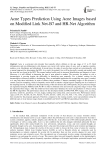
Acne Types Prediction Using Acne Images based on Modified Link Net-B7 and HR-Net Algorithm
Статья научная
Acne is a persistent skin disorder that typically affects children in the age range of 12 to 25. Both inflammatory and non-inflammatory skin diseases can coexist with various types of acne, such as papules, pustules, nodules, cysts, blackheads, and whiteheads. In recent times, the study of acne has been carried out conventionally, with a manual approach for determining the ROI. As a result, the patient's face will be physically counted and marked with the acne that was found in the ROI. This manual method could result in incorrect identification and diagnosis of acne. Moreover, it is still difficult to determine the type of acne related to another. The necessity for patients to visit a dermatologist is growing despite the difficulties in identifying acne manually. For a patient, waiting for the dermatologist to become available is challenging. Thus, an automated application for recognizing acne types is needed, as it may help these individuals. In order to address these problems, a dataset containing images of skin diseases is created. Lanczos resampling, which is frequently used to shift or enhance a digital signal's sampling rate by a fraction of the sampling interval, is employed in the preprocessing of the skin disease data. Subsequently, the pre-processed images are segmented using the Modified Link Net-B7 in order to eliminate noise and correctly categorize images of acne with the segmented skin images. After the model has been trained and validated, the Acne type prediction is forecast using the HR-Net algorithm. The performance metrics for this developed model are FPR, FOR, NPV, kappa, error, accuracy, precision, sensitivity, specificity, f1-score, kappa, training time, testing time, and execution time. Performance metrics values of 95.17%, 94.10%, 92.33%, 96.34%, 93.15%, 85.74%, 4.83%, 4%, 6%, 95%, 7.7%, 1492, 23 and 1515 have been reached for the proposed approach. Therefore, compared to the existing models, Acne type prediction using the different types of Acne disease images based on modified Link Net-B7 and HR-Net algorithm performs better.
Бесплатно
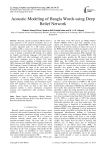
Acoustic Modeling of Bangla Words using Deep Belief Network
Статья научная
Recently, speech recognition (SR) has drawn a great attraction to the research community due to its importance in human-computer interaction bearing scopes in many important tasks. In a SR system, acoustic modelling (AM) is crucial one which contains statistical representation of every distinct sound that makes up the word. A number of prominent SR methods are available for English and Russian languages with Deep Belief Network (DBN) and other techniques with respect to other major languages such as Bangla. This paper investigates acoustic modeling of Bangla words using DBN combined with HMM for Bangla SR. In this study, Mel Frequency Cepstral Coefficients (MFCCs) is used to accurately represent the shape of the vocal tract that manifests itself in the envelope of the short time power spectrum. Then DBN is trained with these feature vectors to calculate each of the phoneme states. Later on enhanced gradient is used to slightly adjust the model parameters to make it more accurate. In addition, performance on training RBMs improved by using adaptive learning, weight decay and momentum factor. Total 840 utterances (20 utterances for each of 42 speakers) of the words are used in this study. The proposed method is shown satisfactory recognition accuracy and outperformed other prominent existing methods.
Бесплатно

Acoustic Signal Based Fault Detection in Motorcycles – A Comparative Study of Classifiers
Статья научная
The sound patterns generated by the vehicles give a clue of the health conditions. The paper presents the fault detection of motorcycles based on the acoustic signals. Simple temporal and spectral features are used as input to four types of classifiers, namely, dynamic time warping (DTW), artificial neural network (ANN), k-nearest neighbor (k-NN) and support vector machine (SVM), for a suitability study in automatic fault detection. Amongst these classifiers the k-NN is found to be simple and suitable for this work. The overall classification accuracy exhibited by k-NN classifier is over 90%. The work finds applications in automatic surveillance, detection of non-compliance with traffic rules, identification of unlawful mixture of fuel, detection of over-aged vehicles on road, vehicle fault diagnosis and the like.
Бесплатно
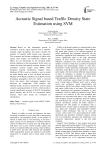
Acoustic Signal based Traffic Density State Estimation using SVM
Статья научная
Based on the information present in cumulative acoustic signal acquired from a roadside-installed single microphone, this paper considers the problem of vehicular traffic density state estimation. The occurrence and mixture weightings of traffic noise signals (Tyre, Engine, Air Turbulence, Exhaust, and Honks etc) are determined by the prevalent traffic density conditions on the road segment. In this work, we extract the short-term spectral envelope features of the cumulative acoustic signals using MFCC (Mel-Frequency Cepstral Coefficients). Support Vector Machines (SVM) is used as classifier is used to model the traffic density state as Low (40 Km/h and above), Medium (20-40 Km/h), and Heavy (0-20 Km/h). For the developing geographies where the traffic is non-lane driven and chaotic, other techniques (magnetic loop detectors) are inapplicable. SVM classifier with different kernels are used to classify the acoustic signal segments spanning duration of 20–40 s, which results in average classification accuracy of 96.67% for Quadratic kernel function and 98.33% for polynomial kernel function, when entire frames are considered for classification.
Бесплатно
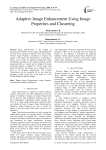
Adaptive Image Enhancement Using Image Properties and Clustering
Статья научная
Image Enhancement is the method of improving the visibility of given image. Image Properties are used for the analysis of Quality of the given image. Various image Properties considered to improve the quality of the image. The Classification or grouping of images can be made by applying unsupervised image Classification algorithm. In our proposed method, various image properties are studied and an Adaptive K-means Clustering method is applied for Fractal image with Entropy Properties. The images are to enhanced on the basis of its grouping automatically. The resulted Classification can be acceptable by the user since the grouping is made on the type of the image i.e., Good Visible, Moderate and Blur images.
Бесплатно
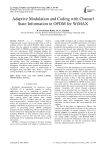
Adaptive Modulation and Coding with Channel State Information in OFDM for WiMAX
Статья научная
WiMAX is a broadband wireless communication system which provides fixed as well as mobility services. The mobile-WiMAX offers a special feature that has adopted an adaptive modulation and coding (AMC) in OFDM to provide higher data rates and error free transmission. AMC technique employs the channel state information (CSI) to efficiently utilize the channel and maximize the throughput with better spectral efficiency. In this paper, LSE, MMSE, LMMSE, Low rank (Lr)-LMMSE channel estimators are integrated with the physical layer. The performance of estimation algorithms is analyzed in terms of BER, SNR, MSE and throughput. Simulation results proved that increment in modulation scheme size causes to improvement in throughput along with BER value. There is a trade-off among modulation size, BER value and throughput.
Бесплатно
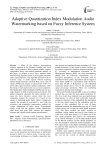
Adaptive Quantization Index Modulation Audio Watermarking based on Fuzzy Inference System
Статья научная
Many of the adaptive watermarking schemes reported in the literature consider only local audio signal properties. Many schemes require complex computation along with manual parameter settings. In this paper, we propose a novel, fuzzy, adaptive audio watermarking algorithm based on both global and local audio signal properties. The algorithm performs well for dynamic range of audio signals without requiring manual initial parameter selection. Here, mean value of energy (MVE) and variance of spectral flux (VSF) of a given audio signal constitutes global components, while the energy of each audio frame acts as local component. The Quantization Index Modulation (QIM) step size Δ is made adaptive to both the global and local features. The global component automates the initial selection of Δ using the fuzzy inference system while the local component controls the variation in it based on the energy of individual audio frame. Hence Δ adaptively controls the strength of watermark to meet both the robustness and inaudibility requirements, making the system independent of audio nature. Experimental results reveal that our adaptive scheme outperforms other fixed step sized QIM schemes and adaptive schemes and is highly robust against general attacks.
Бесплатно
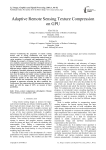
Adaptive Remote Sensing Texture Compression on GPU
Статья научная
Considering the properties of remote sensing texture such as strong randomness and weak local correlation, a novel adaptive compression method based on vector quantizer is presented and implemented on GPU. Utilizing the property of Human Visual System (HVS), a new similarity measurement function is designed instead of using Euclid distance. Correlated threshold between blocks can be obtained adaptively according to the property of different images without artificial auxiliary. Furthermore, a self-adaptive threshold adjustment during the compression is designed to improve the reconstruct quality. Experiments show that the method can handle various resolution images adaptively. It can achieve satisfied compression rate and reconstruct quality at the same time. Index is coded to further increase the compression rate. The coding way is designed to guarantee accessing the index randomly too. Furthermore, the compression and decompression process is speed up with the usage of GPU, on account of their parallelism.
Бесплатно
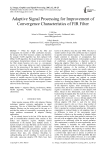
Adaptive Signal Processing for Improvement of Convergence Characteristics of FIR Filter
Статья научная
When the length of the filter and consequently the number of filter coefficients increase, the design of the filter becomes complex and therefore the popular NLMS algorithm has been replaced with MMax NLMS algorithm. But its performance in terms of convergence characteristics reduces to an extent though the filter design becomes very easy i.e., convergence occurs at a later stage taking too much computational time for the processing of the signal. In this paper, a proposal for improving the convergence characteristics is made without compromising the performance of the design and affecting the tap-selection process of the MMax NLMS algorithm. With the introduction of the concept of variable step-size for the filter coefficients, loss in the performance due to MMax NLMS algorithm can be effectively lowered and the convergence is better achieved in the filter deign.
Бесплатно
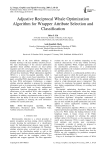
Adjustive reciprocal whale optimization algorithm for wrapper attribute selection and classification
Статья научная
One of the most difficult challenges in machine learning is the data attribute selection process. The main disadvantages of the classical optimization algorithms based attribute selection are local optima stagnation and slow convergence speed. This makes bio¬-inspired optimization algorithm a reliable alternative to alleviate these drawbacks. Whale optimization algorithm (WOA) is a recent bio-inspired algorithm, which is competitive to other swarm based algorithms. In this paper, a modified WOA algorithm is proposed to enhance the basic WOA performance. Furthermore, a wrapper attribute selection algorithm is proposed by integrating information gain as a preprocessing initialization phase. Experimental results based on twenty mathematical optimization functions demonstrate the stability and effectiveness of the modified WOA when compared to the basic WOA and the other three well-known algorithms. In addition, experimental results on nine UCI datasets show the ability of the novel wrapper attribute selection algorithm in selecting the most informative attributes for classification tasks.
Бесплатно
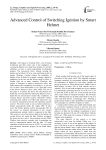
Advanced control of switching ignition by smart helmet
Статья научная
The impact of Accident effect, a lot of human livelihoods and their career, due to the negligence of wearing the helmets on a daily basis in India. To end this suffering, we have a social responsibility development projects. The motorcycle driver without wearing the helmet can be killed if it hit or crash and bring his life in danger. Wearing a helmet reduces the possibility of danger of life. In India, for example, wearing a helmet is mandatory in the law and the drivers need to follow it. Similar rules are in many countries. Therefore, this project is designed to improve motorcycle safety and make motorcyclist compulsory for wearing it. As you can see, we have a lot to think about it. It is a type that is used in the driver's helmet to drive a bike safely. The aim of this paper is to protect the driver life and decrease the death rate at road accident by making the helmet. It uses a hands-free kit and advances feature like compulsory of wearing helmet and theft security. Bluetooth wireless communication module (2.4 GHz band transceiver) can be used for transmission between the transmitter and the receiver. The driver needs to wear a helmet otherwise a helmet automatically keeps the engine OFF. If rider wears the helmet, ignition will be automatically ON. In the sensor, we transmit information to the wireless communication module, which is connected to the bike. This system is one of the devices built in the helmet; the second devices are inside the bike. Monitor recognizes the power devices with a Force-sensing resistor (FSR). Wireless data receiver, encoder, and a transmitter are used to communicate helmet with the bike. AT mega controller in both devices used as a CPU. It is one of the most advanced electronic projects for the Road Safety Systems.
Бесплатно
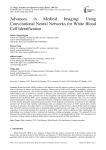
Advances in Medical Imaging: Using Convolutional Neural Networks for White Blood Cell Identification
Статья научная
White blood cells (WBC) perform a vital function within the immune system by actively protecting the body from a wide range of diseases and foreign substances. Diverse types of WBCs exist, including neutrophils, lymphocytes, eosinophils, and monocytes, each possessing distinct roles within the immune response. Neutrophils are typically the initial immune cells to mobilize in response to infections and inflammation, exhibiting a rapid and robust reaction. Conversely, lymphocytes play a pivotal role in the recognition and targeted elimination of pathogens. Nevertheless, identifying and classifying WBCs poses significant challenges and demands considerable time, even for seasoned medical practitioners. The process of manual classification is frequently characterized by subjectivity and is susceptible to errors, thereby potentially compromising the precision of both diagnosis and treatment. In response to this challenge, scholars have devised deep learning methodologies that can automate the process of WBC classification, thereby enhancing its precision. This study employs a convolutional neural network (CNN) to classify WBCs based on imaging data. The CNN underwent training using a substantial dataset comprising body cell images. This training facilitated the acquisition of discerning characteristics specific to various WBC types, thereby enabling accurate classification. The methodology was evaluated within a simulated environment, yielding encouraging outcomes. The approach that was proposed successfully achieved an average accuracy rate of 98.33% in the classification of WBCs. This outcome serves as evidence of deep learning techniques enhancing the speed and accuracy of WBC classification.
Бесплатно
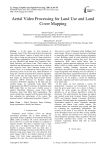
Aerial Video Processing for Land Use and Land Cover Mapping
Статья научная
In this paper, we have proposed an Automatic Aerial Video Processing System for analyzing land surface features. Analysis of aerial video is done in three steps a) Image pre-processing b) Image registration and c) Image segmentation. Using the proposed system, we have identified Land features like Vegetation, Man-Made Structures and Barren Land. These features are identified and differentiated from each other to calculate their respective areas. Most important feature of this system is that it is an instantaneous video acquisition and processing system. In the first step, radial distortions of image are corrected using Fish-Eye correction algorithm. In the second step, the image features are matched and then images are stitched using Scale Invariant Feature Transform (SIFT) followed by Random Sample Consensus (RANSAC) algorithm. In the third step, the stitched images are segmented using Mean Shift Segmentation and different structures are identified using RGB model. Here we have used a hybrid system to identify Man-Made Structures using Fuzzy Edge Extraction along with Mean Shift segmentation. The results obtained are compared with the ground truth data, thus evaluating the performance of the system. The proposed system is implemented using Intel's OpenCV.
Бесплатно
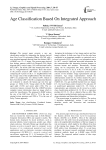
Age Classification Based On Integrated Approach
Статья научная
The present paper presents a new age classification method by integrating the features derived from Grey Level Co-occurrence Matrix (GLCM) with a new structural approach derived from four distinct LBP's (4-DLBP) on a 3 x 3 image. The present paper derived four distinct patterns called Left Diagonal (LD), Right diagonal (RD), vertical centre (VC) and horizontal centre (HC) LBP's. For all the LBP's the central pixel value of the 3 x 3 neighbourhood is significant. That is the reason in the present research LBP values are evaluated by comparing all 9 pixels of the 3 x 3 neighbourhood with the average value of the neighbourhood. The four distinct LBP's are grouped into two distinct LBP's. Based on these two distinct LBP's GLCM is computed and features are evaluated to classify the human age into four age groups i.e: Child (0-15), Young adult (16-30), Middle aged adult (31-50) and senior adult (>50). The co-occurrence features extracted from the 4-DLBP provides complete texture information about an image which is useful for classification. The proposed 4-DLBP reduces the size of the LBP from 6561 to 79 in the case of original texture spectrum and 2020 to 79 in the case of Fuzzy Texture approach.
Бесплатно
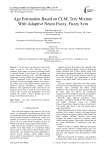
Age Estimation Based on CLM, Tree Mixture With Adaptive Neuron Fuzzy, Fuzzy Svm
Статья научная
As you know, age diagnosis based on the image is one of the most attractive topics in computer .In this paper, we present a intelligent model to estimate the age of face image. We use shape and texture feature extraction from FG-NET landmark image data set using AAM(Active Appearance Model), CLM (Constrained Local Model), tree Mixture algorithms. Finally, the obtained features were given as the training data to the ANFIS (adaptive neuro fuzzy influence system), FSVM (Fuzzy Support Vector Machine). Our experimental results show that In our proposed system, fuzzy svm has less errors and system worked more accurate and appropriative than prior methods. Our system is able to identify age of face image from different directions as is.
Бесплатно
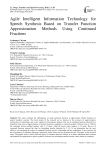
Статья научная
The study considers the methodology of using continued fractions to approximate transfer functions in speech synthesis systems. The main results of the research are an increase in the accuracy of approximation, acceleration of calculations, and a new method of convergence analysis. The use of continued fractions allowed for a reduction in the error of approximation of transfer functions compared to classical methods. With an error of 1.0E-06, the continued fraction method requires only 3–13 terms, while the power series requires 3–15 terms. The use of continued fractions reduced the time for calculating transfer functions by 2–3%. It was determined that the most effective for calculating the values of continued fractions are the Δ-algorithm and the α-algorithm. A new criterion for the convergence of continued fractions is proposed, which allows the sum fractions that are "divergent" in the classical sense. The graphs used to classify different types of continued fractions allowed us to better understand their structure and potential for application in speech synthesis. Software for calculating transfer function values based on continued fraction decomposition has been developed and tested. It has allowed automation of the approximation process and increased the efficiency of speech synthesis systems. The results obtained have allowed improving the quality of synthesised speech while simultaneously reducing the complexity of calculations. Systems using continued fractions consume less memory and provide more accurate voice reproduction. In summary, the work presents a new approach to the approximation of transfer functions, which is essential for optimising speech synthesis systems.
Бесплатно
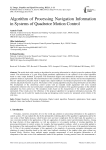
Algorithm of Processing Navigation Information in Systems of Quadrotor Motion Control
Статья научная
The article deals with creating an algorithm for processing information in a digital system for quadrotor flight control. The minimization of L2-gain using simple parametric optimization for the synthesis of the control algorithm based on static output feedback is proposed. The kinematical diagram and mathematical description of the linearized quadrotor model are represented. The transformation of the continuous model into a discrete one has been implemented. The new optimization procedure based on digital static output feedback is developed. Expressions for the optimization criterion and penalty function are given. The features of the creating algorithm and processing information are described. The development of the closed-loop control system with an extended model augmented with some essential nonlinearities inherent to the real control plant is implemented. The simulation of the quadrotor guidance in the turbulent atmosphere has been carried out. The simulation results based on the characteristics of the studied quadrotor are represented. These results prove the efficiency of the proposed algorithm for navigation information processing. The obtained results can be useful for signal processing and designing control systems for unmanned aerial vehicles of the wide class.
Бесплатно
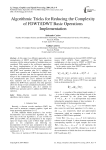
Algorithmic Tricks for Reducing the Complexity of FDWT/IDWT Basic Operations Implementation
Статья научная
In this paper two different approaches to the rationalization of FDWT and IDWT basic operations execution with the reduced number of multiplications are considered. With regard to the well-known approaches, the direct implementation of the above operations requires 2L multiplications for the execution of FDWT and IDWT basic operation plus 2(L-1) additions for FDWT basic operation and L additions for IDWT basic operation. At the same time, the first approach allows the design of the computation procedures, which take only 1,5L multiplications plus 3,5L+1 additions for FDWT basic operation and L+1 multiplications plus 3,5L additions for IDWT basic operation. The other approach allows the design of such computation procedures, which require 1,5L multiplications, plus 2L-1 addition for FDWT basic operation and L+1 addition for IDWT basic operation.
Бесплатно
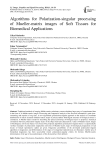
Статья научная
Traditional methods of imaging Muller-matrix polarimetry ensure obtaining large arrays of experimental data in the form of 16 Muller-matrix images. Processing and comparative analysis of the received information is quite time-consuming and requires a long time. A new algorithmic polarization-singular approach to the analysis of coordinate distributions of matrix elements (Mueller-matrix maps) of polycrystalline birefringent structure of biological tissues is considered. A Mueller-matrix model for describing the optical anisotropy of biological layers is proposed. Analytical correlations between polarization-singular states of the object field and characteristic values of Mueller-matrix images of birefringence soft tissue objects were found. The proposed algorithmic polarization-singular theory is experimentally verified. Examples of polarization singularities networks of Mueller-matrix maps of histological preparations of real tissues of female reproductive sphere are given. Diagnostic possibilities of the developed polarization-singular algorithms in diagnostics and differentiation of the stages of extragenital endometriosis are illustrated. Another area of biomedical diagnostics has been successfully tested: polarization-singular criteria for forensic Mueller-matrix determination of the age of myocardial injury of the deceased have been defined.
Бесплатно
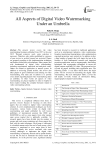
All Aspects of Digital Video Watermarking Under an Umbrella
Статья научная
The present review covers the video watermarking literature published from 1997 to the year 2015. Through extensive work, some selection is necessary. Therefore, only articles published by a process of peer review in archival journal are reviewed. Papers are grouped according to the implementation techniques and further divided into sub techniques. Many papers deal with fundamental of digital video watermarking, including experimental, numerical and analytical works. Others are related to application or natural system. In addition to reviewing journal articles, this review also takes papers of good conferences and meeting on video watermarking. The main aim of authors is to provide every details regarding digital video watermarking under an umbrella. In other words all aspects of video watermarking are placed together in order to helpful to those readers looking the complete literature related to video watermarking scheme.
Бесплатно

